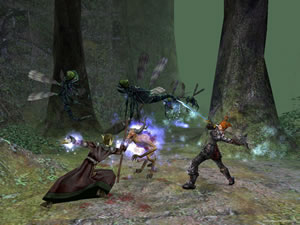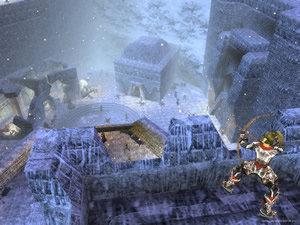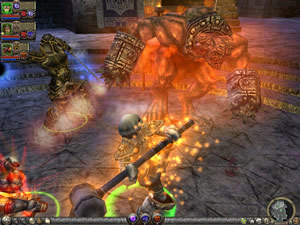Been there, dungeon that.
If you’ve been waiting impatiently for a taste of hack’n slash heaven since your last visit to Diablo II‘s fiery fantasyland, you’ll be disappointed to hear that Microsoft’s Dungeon Siege II delivers an experience that’s neither heavenly nor diabolical, but somewhere in between. The game offers players what every fantasy-themed slasher should: a tour through a gorgeous domain on the way to an ultimate showdown with evil, videogaming’s equivalent to dinner and a movie. But instead of playing hard to get, it’s easier than a co-ed doing body shots.
Still, it tells a tale fit for a disciple of both Diablo and the prior Dungeon Siege. Long ago, avatars of good and evil clashed upon a battlefield. With their mighty arms, they ripped one another to pieces in an awesome cataclysm. The world was laid to ruin, and the weapons of mass destruction were thought lost. Sound familiar?
But wait, it gets cool. An evil Prince musters a following of crab-faced death mages and summons the Sword of Zaramoth, with which he and his legions of evil cohorts wage war upon the world. The trick is, every time one of his buddies gets hacked or slashed, the death mages suck out his soul and send it to the soul volcano, where it stores and crystallizes with the evil souls of other lost soldiers. Then, the crystals are mined and planted near “good” civilizations, where the spirits pour forth from the crystal and possess any they come across, turning them into mindless zombies and agents of evil.
I should note, this is also the basis of Scientology.
Your task, should you choose to purchase it, is to create a hero, make some friends and venture out into the wilderness to smite evil, break the crystal shards and stop Tom Cruise, er, Prince Valdis from destroying the world.
So the plot is a bit typical, but the death crystals and zombie hordes seem promising…until you’re forced to listen to a couple lines of Dungeon Siege II‘s awful dialogue, complete with terrible voice-acting. The conversational cadences make a forest full of undead soldiers seem natural, and all the “good” characters are disgustingly righteous. But for all their heroic rhetoric and the nobility of their cause, they still trek through jungles and slaughter funny little spear-chucking natives by the thousands. As long as it’s for a good cause, right?
But before you get to exterminating nasty little natives, you’ll have to create a hero. You can choose from one of four races: human, half-giant, dryad and elf. Dryads are basically hippy versions of elves, while half-giants are meant to be unusually philosophical according to the game’s lore. I named mine Roid Rage, because he was big and red.
Once you pick a race and hairstyle, you’re off to the trenches. Instead of picking a class outright, you pick from a class of weapons. As you use one class over the other, you’ll essentially become that class. You can focus on nature magic, combat magic, ranged weapons and melee weapons, which basically boils down to the standard four classes of healer, mage, archer and
fighter.
The fighter and archer classes are incredibly boring and one dimensional. Aside from powers and bonuses gained from leveling up, both are limited to moving and attacking. Fighters walk up and repeatedly whack things, while archers stand back and repeatedly shoot things.
The mage and healer classes, by comparison, are much more robust. Instead of basic attacks they get spells that include heals, buffs, snares, curses, nukes and summons. The buffs and curses can be placed in autocast slots, while other spells, like Heal, are placed in one of four “active” slots. These show up next to the given character’s name, and if you click on one of them it will become activated and the caster will use it whenever you tell him or her to attack. You can switch between these to fit a given situation, but Dungeon Siege II‘s pace is so fast, mindless and easy that you’ll never actually need to use the majority of your casters’ abilities. You basically set your phasers on kill and blast away.
This A.I. scheme is so smart, it’s kind of stupid. For example, if you set Heal as your healer’s active spell and something mana-efficient like Jolt on your combat mage, you can forget they exist. Sure, you can always pause the action and arm the perfect spell while targeting the most threatening monster, but you never need to – your comrades’ A.I. can handle the simple tasks of nuking and healing injured party members, and your enemies are too weak to do anything about it. The game almost beats itself.
Did I say almost? Because a fully grown pet is basically ‘game over’ for any enemy. Pets can be bought and then added to the party like henchmen, but instead of gaining experience and levels, they advance based on the items you feed them. When a pet reaches maturity, regardless of species, it will emanate a powerful aura. My dire wolf, for example, puts a 60% melee damage reflection buff on every party member. That’s outrageously powerful…but that’s just half of it. The items you feed a pet affect its growth – if you feed a pet nothing but weapons and healing potions, it will gain lots of strength and health. That’s what I did, and my mature dire wolf wound up with a whopping 1400 hit points and 170 strength. The damn thing has the same armor score as my plate-mail clad half-giant (650 hit points, by the way), making him far and away the most powerful member of the party. Plus, he has the backing of a giant warrior, a healer (he never takes damage, but what they hey), and a sorceress. Roll credits.
 Since you are always in control of a group of adventurers, you have two formation/A.I. settings to play with, Mirror mode and Rampage mode.
Since you are always in control of a group of adventurers, you have two formation/A.I. settings to play with, Mirror mode and Rampage mode.
In Mirror mode, your squad moves as one and attacks as one. In Rampage mode, you can issue individual orders to your units. In almost every case, the most efficient means of attacking your foes is to simply sit in Mirror mode and wave your mouse around while holding the right mouse button. This will basically cause your party, as one, to demolish every single enemy. On the other hand, if your enemies are so far beneath you that they aren’t even worth your attention (as is frequently the case), you can simply set Rampage mode and, I dunno, work on making a cockatrice from web images.
Things get sticky, though, around level 15. You wander into a dungeon and encounter masses of level 24 monsters. In any other game you would be properly screwed, but in Dungeon Siege II you can attack, retreat, heal, and repeat until everything is dead. If you’re facing high-level enemies who can’t spit or throw things at you, you can simply run in circles, which they will follow you in doing, until you’ve healed up.
Once you kill a slew of level 24 enemies at level 15, the game basically ends. Don’t get me wrong – Dungeon Siege II is long, but when you’ve easily dispatched foes 10 levels greater and then face 10 hours of equal-level foes, you can’t take your quest against evil seriously anymore. This game feels more like a trip to an evil petting zoo than a trip to hell and back.
As the bodies pile up around your party, each member will eventually gain levels and skill points to spend on the fruits of a skill tree corresponding to his or her class. They’ll quickly gain massively destructive attacks that only make an easy game easier. Around level 24, I scored a power that reduced my target’s armor drastically and guaranteed that my next 8 hits would be critical. Goodbye bosses, hello treasure.
When you tire of slaying waves of hell dogs and fell bushes, you can immediately teleport back to town and sell off all the junk you picked up, and maybe buy a spiffy new weapon or shield. You’ll have a lot of money and there is usually something interesting on sale every time you visit the shop. There are also several NPCs wandering around to talk to, some of whom will give you side-quests or ask to join your party.
These usually lead you off the beaten path of your primary quests and into the outskirts of the environments, which is Dungeon Siege II‘s most impressive feature. The foliage is lush and dense, you can enter and exit massive dungeons without a single loading screen, and anything that comes between you and the camera is instantly rendered transparent.
Then again, a lot of this could be said for the previous Dungeon Siege game. Even though you seamlessly travel in and out of dungeons, you’ll still be required to use teleporters to travel between areas, interrupting the sense of a whole, cohesive world. But all those handy refinements in the original, like picking up every loose item at the touch of a button, has made it through mostly intact.
 There is a musical score, but it’s nearly always drowned out by the myriad cries of your dying foes. In fact, almost all of the game’s visual and auditory drama is contained within the bodies of your enemies and released when you whack “em with your hammer. This usually results in a “splat” sound effect and the bloody explosion of limbs and viscera. When you really get on a roll, enemies will pop like this left and right. Come to think of it, playing this game is kind of like popping bubble wrap, just not as hard.
There is a musical score, but it’s nearly always drowned out by the myriad cries of your dying foes. In fact, almost all of the game’s visual and auditory drama is contained within the bodies of your enemies and released when you whack “em with your hammer. This usually results in a “splat” sound effect and the bloody explosion of limbs and viscera. When you really get on a roll, enemies will pop like this left and right. Come to think of it, playing this game is kind of like popping bubble wrap, just not as hard.
Dungeon Siege II is also playable online, but only cooperatively. In a nice touch, you can import your party from a single-player game to wreak online havoc, although you’ll still have to start from the beginning, which might mean some backtracking. We were also disappointed to discover that there were no new maps or realms for online players to explore (as there were in the original Dungeon Siege) – it’s co-op the single-player campaign or bust. You can also play through Gamespy, in which case you’ll have to create an entirely new character.
But Dungeon Siege II is so easy solo than when played with a group it’s barely even a game. I can just have my sorceress cast her weakest combat spell constantly so that she never runs out of mana while my other characters mop up. My healer is utterly idle until somebody gets hurt, and then she heals. When everybody operates to the fullest of their abilities, there’s rarely a monster left for them to operate on. Again, the challenge just isn’t there.
So can that conundrum be solved? No, not at first. There are multiple difficulty levels, but they have to be unlocked, meaning that before you ever taste anything resembling difficulty, you will have waded through a dozen hours or more of pure cotton-candy. *sigh*
The original Dungeon Siege was a study in gameplay refinement, introducing a multitude of simple concepts that really changed PC role-playing for the better. Though some of that is still here, it’s not so thrilling anymore. Dungeon Siege II is so streamlined that it has lost its hardcore edge. It still looks pretty and is a great way to relieve some stress after a tough day at work, but if you’re looking for a challenge, this is one dungeon to crawl away from.
-
Looks awesome
-
Very accessible
-
Gets tedious
-
WAY too easy







